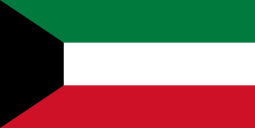The flag of Kuwait (علم الكويت) was adopted on 7 September 1961, and officially hoisted 24 November 1961. Before 1961, the flag of Kuwait was red and white, like those of other Persian Gulf states at the time, with the field being red and words or charges being written in white. It is the only flag in the world featuring an acute trapezium.
 | |
| Alam Baladii, Derti | |
| Use | Civil and state flag, national ensign |
|---|---|
| Proportion | 1:2 |
| Adopted | 7 September 1961 Officially hoisted 24 November 1961 |
| Design | A horizontal triband of green, white and red; with a black trapezium based on the hoist side. |

When the Utub settled in Kuwait, Kuwaiti ships were flying a flag common on the western coast of the Persian Gulf, a red flag added to it near the mast a serrated white ribbon similar to the current Bahrain flag and was called in the name of the Sulaimi flag. This flag was raised in the rule of Sheikh Sabah I bin Jaber in 1752 to 1871.
During the period of Ottoman rule in Kuwait, the Ottoman flag, red with a white crescent and star, was used. This flag was retained after the country became a British protectorate in the Anglo-Kuwaiti Agreement of 1899.
In 1903, Lord Curzon, the British Viceroy and Governor-General of India visited Kuwait, and Sheikh Mubarak Al-Sabah received him and raised a red flag with white words, توكلنا على الله (We trust in God) in Arabic writing. This avoided the diplomatic faux pax, given Kuwait was under British protection, of raising the Ottoman flag.
Two different flag designs were proposed but not adopted in the period after this. The first proposal in 1906, a red flag with white Western letters spelling (KOWEIT) and the second in 1913, the Ottoman flag but the word كويت (Kuwayt) in Arabic writing as a canton.[1][2]
The Ottoman flag kept being used until the First World War, when friendly-fire incidents with the British in 1914 during the Mesopotamian campaign around the river Shatt al-Arab occurred due to Kuwait and the enemy Ottomans both using the same flag. Because of this Kuwait adopted a new flag, red with كويت (Kuwait) in Arabic writing.[3][1][2] This flag was in use until 1921, when Sheikh Ahmad Al-Jaber Al-Sabah added the Shahada to the flag.[4][1][2] This version was in use until 1940, when he also added a stylized falcons claw to the flag.[1][2] These flags were also depicted on the Emblems of Kuwait. The red flag remained the national flag of Kuwait until the adoption of the current one in September 1961. The present flag is in the Pan-Arab colours, but each colour is also significant in its own right.
| Scheme | Textile colour |
|---|---|
| Red | The Hashemite dynasty, symbolizes the blood on the swords of Muslim warriors. |
| White | The Umayyad dynasty, symbolizes purity and noble deeds. |
| Green | The Fatimid dynasty or Rashidun Caliphate, represents the fertile land of Arabia. |
| Black | The Abbasid dynasty, represents the defeat of enemies in battle. |
The colours' meaning came from a poem by Safie Al-Deen Al-Hali:
- White are our deeds
- Black are our battles
- Green are our lands
- Red are our swords
Rules of hanging and flying the flag:
- Horizontally: The green stripe should be on top.
- Vertically: The red stripe should be on the left side of the flag.

In 2005, it became the design of the world's largest kite at a size of 1019 square metres. It was made in New Zealand by Peter Lynn, launched to the public for the first time in 2004 in the United Kingdom, officially launched in Kuwait in 2005, and has not been surpassed since.
The flag can also appear to resemble the corner of a room, with the green and red being the ceiling and floor, and mismatched black and white walls.
Construction sheet
editStandard of the Emir
editThe current Emir of Kuwait has a personal royal standard, which is the national flag with a yellow crown on the green stripe.
-
Standard of the Emir 1961–present
Historical flags of Kuwait
editReferences
edit- ^ a b c d Hubert de Vries (2018) [2011]. "KUWAIT دولة الكويت". hubert-herald.nl. Retrieved 10 January 2019.
- ^ a b c d Mello Luchtenberg. "Kuwait". vexilla-mundi.com. Retrieved 10 January 2019.
- ^ Nunn, Wilfred (1932). Tigris Gunboats: The Forgotten War in Iraq, 1914-1917. Naval Institute Press. p. 33. ISBN 978-1861763082.
- ^ Farkas Al-Rashoud, Claudia (1993). Kuwait's Age of Sail : Pearl Divers, Sea Captains, and Shipbuilders Past and Present. Husain Mohammed Rafie Marafie. ASIN B000E4QEN4.